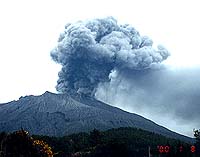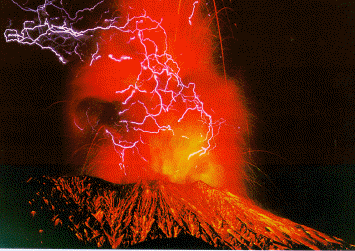SAKURAJIMA, Southern Kyushu
(31o35'06"N, 130o39'25"E)
(10/16/00)
According to the Volcano Observation Reports on Sakurajima Volcano by JMA, Minamidake (south-mountain) of Sakurajima Volcano erupted on 16:42, 7 October; 132-nd explosion in this year. Eruption column reached 5,000 m above the crater, associated with 18 thunders. The maximum amplitude of the explosion earthquake was 4 micro-meters at the JMA observation point, 4.6 km WNE of Mindamidake. Abundant ash fell over the central and northern parts of the city of Kagoshima. Lapilli, 3 cm of maximum, fell over the NW of the volcanic island. Front glasses of 35 cars were broken there. Since the explosion, no large change had been observed, although small numbers of volcanic earthquakes had occurred.
(1/26/00)
According to the JMA observation reports on Sakurajima, the daily eruption and explosion numbers during 14-23 January are as follows;
Jan 14 = 7 (6): explosions in (..)
Jan 15 = 1 (0)
Jan 16 = 1 (1)
Jan 17 = 0 (0)
Jan 18 = 0 (0)
Jan 19 = 2 (2)
Jan 20 = 1 (1)
Jan 21 = 1 (1)
Jan 22 = 0 (0)
Jan 23 = 2 (2)
Information contact: JMA-Fukuoka: n-uchida@met.kishou.go.jp, VRC-ERI: nakada@eri.u-tokyo.ac.jp, Tatsuro Chiba: ta.chiba@ajiko.co.jp

Eruption at Sakurajima on 8 January 2000.
Taken 3.5 km SW of the Minamidake (active crater) at 9 a.m. by Tatsuro Chiba
(1/14/00)
According to the JMA observation reports on Sakurajima, the daily eruption and explosion numbers during 4-13 January are as follows;
Jan 4 = 5 (0): explosions in (..)
Jan 5 = 9 (9)
Jan 6 = 5 (2)
Jan 7 = 5 (5)
Jan 8 = 7 (3)
Jan 9 = 1 (1)
Jan 10 = 2 (2)
Jan 11 = 0 (0)
Jan 12 = 2 (2)
Jan 13 = 3 (3)
The activity on January 5 was high in level (9-th highest record in daily eruption number since 1955; 1-st is 13 explosions on November 29, 1973). An explosion at 03:54 of January 5 issued cinders and bombs down to a middle flank of the volcano. The highest plume during these days was 2,200 m above the crater rim for both the 08:21 explosion on January 5 and the 07:46 explosion on January 14. The maximum amplitude of explosion seismic signals at the JMA observation point A (4.6 km WNW of the active crater) was 17 micrometer for the 05:13 explosion on the same day.
(1/11/00)
According to the JMA observation report on Sakurajima Volcano, #1 of 2000, total number of eruptions last year was 386, including 237 explosions. Occurrence of eighty-eight explosions last December was the second highest record as a monthly frequency since 1955; the first, 93 explosions in June 1974. The daily numbers of eruptions and explosions in parenthesis are as follows;
December 28 = 2 (2)
December 29 = 1 (1)
December 30 = 7 (3)
December 31 = 10 (6)
January 1 = 2 (1)
January 2 = 5 (5)
January 3 = 7 (4)
An explosion at 18:34 (JST) on 2 January issued abundant cinders including bombs in the middle flank of the volcano. Two thousands and two hundred m-height eruption column was observed in the 16:30 eruption the same day.
(12/30/99)
Eruptive activity at Sakurajima had been high in latest October and early November---Volcanic Advisory No.3 on Sakurajima Volcano was issued by JMA on 31 October--; 19 eruptions from the Minamidake (historically active cone) in early November, including 18 explosions. The activity had been relatively low in level during middle and late November. However, Sakurajima was activated in early December, such that a few explosions occurred in a day, and small amounts of ballistics were inssued in the upper slope of the volcano.
JMA issued Volcanic Advisory No. 4 on Sakurajima Volcano on the afternoon of 10 December. At 05:55 this day, Sakurajima issued large amount of bombs down to 4/10 of the slope from the base. Fire column as high as 100 m was witnessed, being accompanied by 116 times of volcanic lightning. According to the field inspection by JMA, ballistics scattered about 3 to 4 km away from the Minamidake crater by this eruption; the maximum size was 4 cm across. Fire column as high as 300 m together with 6 times of volcanic lightning was also observed at 05:54, December 24.
Daily number of eruptions ranges from 2 to 8 during early to middle December; eruptions were mostly explosions. The maximum amplitude of explosion earthquakes recorded at the observation point A of JMA, 4.6-km WNW of the crater, reached up to 28 micron-meters; the largest value was by the explosion at 13:01 on December 12. The plume height of explosions in December ranges from 1,500 m to 2,000 m.
The total number of eruptions in December is 85, including 77 explosions. Explosions took place everyday during 23 days (3 to 25 December). This is the longest record since JMA started observation at Sakurajima in 1955; the second record is 21 days in 1960. The total number of explosions in 1999 reaches 226. JMA issued several Volcanic Observation Reports since 10 December and had called local people's attension to the volcanic activity.
Information contact: JMA-Fukuoka, n-uchida@met.kishou.go.jp; Volcano Reseach Center, ERI, U-Tokyo, nakada@eri.u-tokyo.ac.jp
(9/17/99)
The activity of Sakurajima Volcano had been in a high level during 28 July-13 August 1999; JMA issued Volcanic Advisory #2 on 2 August. The eruption at 20:22 on 30 July, 22:16 on 1 August and 00:30 on 2 August issued ballistics down to the middle of the slope. Sakurajima became relatively quiet after 13 August; the number of explosion during 13-22 August reduced to 5 times. Total number of explosion this year as of 23 August is 78.
Information contact: JMA, Volcano Research Center, ERI, U-Tokyo
(6/1/99)
Sakurajima in January 1999 is characterized by a low level of volcanic earthquakes, though 13 eruptions occurred. During February-April occurred 44 eruptions including 15 explosions. Eruptive activity was relatively high during March 11-16, being associated with 10 eruptions including 8 explosions. The height of eruption column reached 1,800 m above the crater on 20 April. In May, it is relatively low in level.
The amount of tephra deposition around the volcano peaked during 1991-1992 (up to 5.8 million ton per month) in this decade and had decreased; presently very scarce, down to less than 3x10^5 ton/mo.
(5/21/98)
According to Volcano Observation Report of Sakurajima (#1), a swarm of volcanic earthquakes continued from 17:00, 19 May, to after 00:00 of the following day. The daily numbers of earthquakes were 334 and 41 on 19 and 20 May, respectively. Ten eruptions occurred during 20-21 May (as of 14:00, 21 May), including 9 explosions. Total 49 explosions occurred by this day in this year.
(5/20/98)
"Volcanic Advisory" on Sakurajima Volcano, #1, was issued from JMA on the evening of 19 May. A swarm of volcanic earthquakes started around 17 h (JST) of this day, and the number of earthquakes reached about 220 during the following four hours. JMA called an attention to the public, as the activity level may increase. The number of explosions at Sakurajima Volcano is 40 as of 19 May, while that in last year was 35.
Information contact Tomoyuki KANNO, JMA-Fukuoka; kanno@redc-fk.eqvol.kishou.go.jp, VRC-ERI, U-Tokyo; nakada@eri.u-tokyo.ac.jp
(February 4, 1998)
Sakurajima was relatively quiet throughout most of 1997. The annual frequency of tremors, N=4,466, is the smallest record since 1965, according to JMA. That of explosion, N=35, is the fifth smallest record since 1955 (the smallest record is 10 times in 1971). However, Sakurajima has been activated to some extent since December 1997. JMA counted explosions of 8 times in December and 10 times in January (as of January 27). According to Sakurajima Volcanological Observatory (SVO), Kyoto University, monthly numbers of A- and B-type earthquakes and explosions were relatively high in December and January. The 3-December explosion issued ash of at least 70,000 ton.
Information contact: Sakurajima Volcanological Observatory (SVO), Kyoto University, e-mail: ishihara@svo.dpri.kyoto-u.ac.jp; Japan Meteorological Agency (JMA)
(June 16, 1997)
According to JMA, Sakurajima had been still relatively quite with small numbers of explosions during February-May; zero in Feb., three times in Mar., one in Apr. and 6 in May. Earthquakes were moderate in March and April, however. An explosion took place on 11 May; the air-shock of the explosion was felt, and bombs of the explosion reached down to 4/10 of the slope of Sakurajima. The magnitude was much smaller than the explosion on December 14, 1996, according to Sakurajima Volcano Observatory (SVO), Kyoto University. The latter had reported increasing number of A-type quakes during these months.
Information contact: Sakurajima Volcanological Observatory (SVO), Kyoto University; Japan Meteorological Agency (JMA)
(February 10, 1997)
These several months Sakurajima is relatively quite with very small numbers of explosions and the B-type earthquakes. According to SVO, explosions at Sakurajima were detected seismologically twice in October 1996, eight times in November, and three times in December; none in January 1997. JMA reported the explosion at 05:24 JST, 14 December 1996, issued abundant bombs onto the middle slope of the volcano, associated with fourteen thunders and a 200 m-high fire column during 10 seconds.
Information contact: Sakurajima Volcanological Observatory (SVO), Kyoto University; Japan Meteorological Agency (JMA)
(October 2, 1996)
Seismological activity at Sakurajima Volcano which has been monitored by SVO (Sakurajima Volcanological Observatory, KYOTO University) indicates occurrence of four explosions in June, one in July, and five in September.
(June 1, 1996)
According to JMA, forty two explosions occurred in January, including18 explosions during 24-31 January. Thirty-one explosions in February; at 20:11 JST on 27 Feb. cinders reached on the middle of the volcano slope. This March has 69 times of explosions; the fifth largest record of monthly explosion frequency since October 1995 when eruption started at the Minami-dake, the present active center. Three explosions among them were recognized to be associated with cinder spout. Twelve times of explosions on 18 March was the second largest record of daily frequency since 1995. The activity had declined since then, with 5 small explosions in April and one in May. The explosion on 16 May spouted large cinders to the NW, 2 km away from the crater.
According to SVO, amounts of air-fall tephra, explosion frequency, and earthquakes of BL type, together with the activity of surface and shallow earthquakes, had reduced since March. Long-term evaluation on the activity by SVO based on their monitoring results, including sea-level change and GPS observations, that accumulation of magma just below Sakurajima Volcano has advanced slowly and steadily since 1994.
(January 1996)
Sakurajima Volcano that is breathing frequently explored strongly in August and October. On 25 August, volcanic bombs landed on the mid-slope of the volcano. The eruption column reached up to 3 km above. Tephra covered widely the northern area, including Kagoshima City, causing heavy traffic damage.
 (left photo) Explosive eruption with lightning at Sakurajima Volcano (23:03 on18 May 1991)
(left photo) Explosive eruption with lightning at Sakurajima Volcano (23:03 on18 May 1991)
to Decade page
Eruptions at Sakurajima Volcano occurred more than 200 times in 1995; the most active of these four years. Total amount of erupted materials during 1995 is estimated approximately 3 - 4 million ton, according to the Sakurajima Volcanological Observatory (SVO), Kyoto University. The latter is observing the continuous uplifting of the northern side of Sakurajima, implying accumulation of magma beneath the volcano, and potential explosive eruption near future.
To eruption menu

